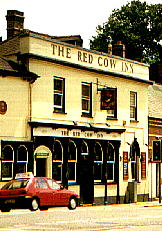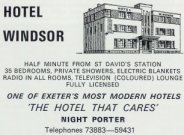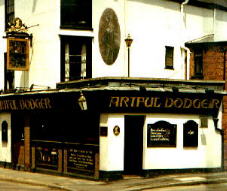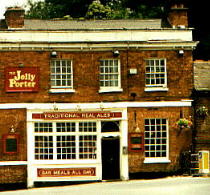
|

|
| Use the text links for more information! |
|
|
Cowley Bridge Pubs abound, The Cowley Bridge Inn, is the furthest away which you may have seen just before your train entered the city on your left hand side. This pub will take you a while to get to though. Its a good 15 - 20 minute walk along Cowley Bridge Road. The more sensible of us who never got on the train in the first place would drive or better still get some other mug to drive. Cowley Bridge stands at an ancient crossing point. A bridge is recorded in 1286. Floods in 1809 and 1810 demolished the old stone bridge and the present structure was built in 1813-14, designed by the county surveyor James Green. |
| Station Square
Other pubs within the Station Square or very
close by are The Loco Bar in the Great Western Hotel, The Red Cow Inn, The Jolly Porter and The Artful Dodger.
Brief details are given below.
Red Cow Village housed the rail workers with the Red Cow Inn and Jolly Porter providing the refreshment for
travellers coming to and from the station by coach and horse omnibuses. By the 1830's, Exeter had become an
important transport centre. Two railways shortly arrived on the northern side of the City. The Bristol & Exeter
line via the Culm and Exe Valley established St Davids Station in 1844 in Pennroyal Fields. The isolation of St
Davids was gone for good. A new road was then built to link the station with Exe Bridge, making a further exit
from the City to the north.
The London and South western Line came through to Queen Street via Longbrook Valley in 1860 forcing the Bristol
and Exeter Company to re-build St Davids Station. Competition between the two rail companies was intense
until they were merged into British Rail in 1947. With the break up of British Rail into regional and national rail
companies and Railtrack, the station was taken over by the Great Western Train Company, now First Great Western.
The London and South Western Railway (later the Southern Railway) used the tracks around St Davids' and had running
powers as far as Cowley Bridge junction, however this alway caused conflict and in the 1930's a scheme was proposed
to have an independant Southern Railway Station on top of St Davids solely for the use of the Southern Railway.
The line from Central Station (formerly Queen St Station) falls at gradient of 1:37 to meet the GWR lines. The idea
was dropped with the outbreak of war.
Just Opposite the station used to be the main Royal Mail sorting office.
This has now moved to Sowton Industrial Estate and the vacated area has
been used to house students with the actual sorting office site housing a bookshop
and cafes.
|

|
The Great Western Hotel - Loco Bar - Excellent choice of real
ales, Exe Valley and Otter Breweries. The bar menu is extremely compehensive
but if you'd like to pay more, you can use Brunel's Restaurant in this
very same hotel. I've never eaten here but by all accounts its very good.
A map of 1876 shows this place to be the Railway Hotel, the original building dating from 1848 with later
extensions from around 1860.
You can access their site via the links page.
The Red Cow Inn - Unfortunately closed in October 2002 having lost alot of custom, the building may re-open as a pub. It was owned by Heavitree brewery from around 1900. When St David's Station was built in 1844, it was proposed that the station was called 'Red Cow' Station after the Pub. The village in which it now stands had previously adopted that name. Some believe that before the building became a pub, it was a convent. The inn was also a toll house in the C19th, Red Cow Gate. The Artful Dodger - good selection of beers, good pool table and a friendly atmosphere makes this a good pub to have a relaxing drink in. Very popular with the students from the halls nearby. Listed in Kelly's directory (1970) as The John Bull Inn. The Jolly Porter - Has a pool table and the split level means you can always find a quiet spot to sit and chat. Good beers. Used to be the Elmfield Hotel. |
 |
|
|
|
|
|
At the end of St Clements Lane, the rectangular shaped structure replaced a Georgian row of houses that had been
converted into St Davids' Family & Commercial Hotel. This was a 'temperance hotel' which I think means that it did not
have a bar or serve alcohol. The hotel was demolished in the 1920's and was replaced by
the current building that once housed the Windsor Hotel. Before the place closed in the early 1990's it was known
briefly as Chuffers Hotel. It housed possibly one of the worst bars in Exeter, Chuffers Bar! The place is still used for residential purposes.
 |
| Once you've finished in these bars head up the hill to The Imperial, The Imperial is on your left, just before Howell Rd. The Imperial was originally built as the private Elmfield House in 1810 with the only entrance from St Davids Hill. The original gatehouse lodge still stands today. Elmfield house was the home of Dr Heberden, renowned for his studies in arthiritus. The people of St Davids used to hold their annual fete in his extensive grounds. This place is enormous with several bars and rooms. Good cheap Beer. Its a Wetherspoons pub which means no music, and no smoking at the bar. If you can put up with this and the large number of people crowding in sometimes then fine. The driveway will take you up to the pub by the lodge. |
|
The large conservatory that now makes up the large west bar of the pub was brought here and
re-erected from Streatham Hall
(now Reed Hall) in the University grounds.
James Green, the famous local engineer, the man responsible for the extensions to Exeter Canal and the Canal Basin was once a resident of Elmfield House. There is further information and an old advertisement on the pop up. The Imperial Hotel was purchased by JD Wetherpsoons from the Hawkes-Williams' who had run the place as a hotel for 40 odd years in 1994, opening as a pub on 14th March 1996 having spent £1.45m. Also close by is Taddyforde House, once part of 'Taddyforde' documented as early as 1280. |
 |
 |
 |
 |
|
Exit the Imperial by the New North Road opening and turn right, you'll pass Howell Road. Between here and
Hele Road stand the red breccia Attwill's Almshouses built here in 1839. Originally located just outside
the northern wall of the city, they had fallen into disrepair and trust funds were used to build these
newer 'old' houses.
When New North Road was constructed by the Turnpike Trust in the 1840's, it cut through Bury Meadow (seen opposite the Buller Statue). This meadow at the time extended into the Longbrook Valley. Hele Road made a further important link with St Davids Hill, disturbing the meadow further. Bury Meadow cottage can be seen opposite the statue, this was probably once a toll house. |
|
Exeter College Turn left into Hele Road and on the right is Exeter College. Before the tower was built in 1963, this plot belonged to Hele School. The red brick and grey stone building were part of Hele School, opened in 1849 for 88 boys. The school was the fulfilment of a legacy of Elize Hele back in 1632. The school was relocated to Broadfields in Heavitree in 1959 and is now known as St Peters C of E High School. Anyone with kids of secondary school age will be well aware of this school's good reputation. The big problem is getting your kids in if you're outside the catchment area. So much for parental choice. Make sure your kids go to church until they're at least 12! The tower had a facelift in 1992/93 to soften the impact of the building on the surrounding area. The windows and external facade were altered. Demolition would have been a better idea although the view from the top is fantastic. |
St David's Church
St David's Church is dedicated to the Welsh Saint. A chapel was supposedly
founded outside the city wall in the 7th century by St David. Devon and
Cornwall were once called 'West Wales' and communications with Wales itself
were very good until Athelstan
(King Alfred's Grandson) drove the Celts
from Exeter helping to make England one kingdom for the first time in the
10th century. The Celts however remained in the area, and in fact the lower
part of St David's Hill is still known as 'Little Britain'.
The Church is victorian and has received praise in the past for its
victorian architectural values from Sir John Betjamin.
|
| Duryard
This whole area, St Davids Hill and the area to the north were part
of the Manor of Duryard, where Norman Kings would hunt deer and boar in
the woodlands. The area upon which the University is now sited. King Athelston gifted
the manor to the City in the 10th century. The Domesday Book
shows that the citizens
of Exeter cultivated 960 acres of Duryard and that the woods provided timber for building
in the City. Duryard Valley is now a park and nature reserve, part of a green belt around
the city. This came about after a 1980's campaign when a developer wished to build on
the steep slopes of the valley but was prevented from doing so.
The Duryard Estate was bought from the City in the late C17th by Thomas Jefford. He was
Mayor of Exeter between 1687 to 1688. He was a leading light in the Exeter
woollen cloth trade,
engaged particularly in the dyeing of the cloth. He was knighted by
James II after he presented
the King with a piece of cloth dyed scarlet and blue on opposite sides.
Sneaky, crawling bastard. Anyway he built Great Duryard on Cowley
Bridge Road, now known as Thomas Hall
which is currently used by students as a hall of residence. |
| University Exeter University is built on the Streatham Estate purchased by the school of education by Alderman Reed. The deal included Streatham Hall (since re-named Reed Hall). The first purpose built buildings were the Washington Singer Labs completed in 1922, named after their benefactors, the Singer sewing machine family. The university got it's charter in 1955. |
Buller The statue of General Sir Redvers Buller stands on the road intersection. This man had a particularly magnificent military career. His most heroic actions were in South Africa between 1878 and 1879, for which he was awarded a Victoria Cross, but he has otherwise been awarded more medals than Manchester United. Buller was born at Downes near Crediton in 1839 and became the most famous soldier ever to come from the West Country having joined the Kings Own Rifles at the age of eighteen. The man was also very generous. Amongst many other donations he made within the city he also donated the land upon which Exwick School was built in 1858. You will see his name crop up many times on these pages. He died in 1901. |
 |
 |
|
|
Carry on down Hele Road to the mini-roundabout and turn left up St Davids Hill to the Local Plus Store on the left.
This was once the Packhorse Inn and was one of the
original St Davids pubs introduced at the height of the packhorse trade mentioned earlier. It closed in 1998.
Nip into the Northbridge Inn further down Iron Bridge Street
on your right just at the start of the bridge. When the Iron Bridge was brought from Wales in 1836 the North Bridge Inn
was first suggested and the name and pub have been registered since 1840. There are many original Georgian features
in the building including some very well preserved and rare ceiling plaster work. Unfortunately this pub closed in
November 2008.
Close to here is Mount Dinham,
which is well worth a visit. As well as rows of neatly kept houses there is also St Michael and All Angels Church.
Stuart Callon Copyright ©2002, 2003 |